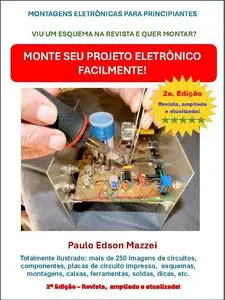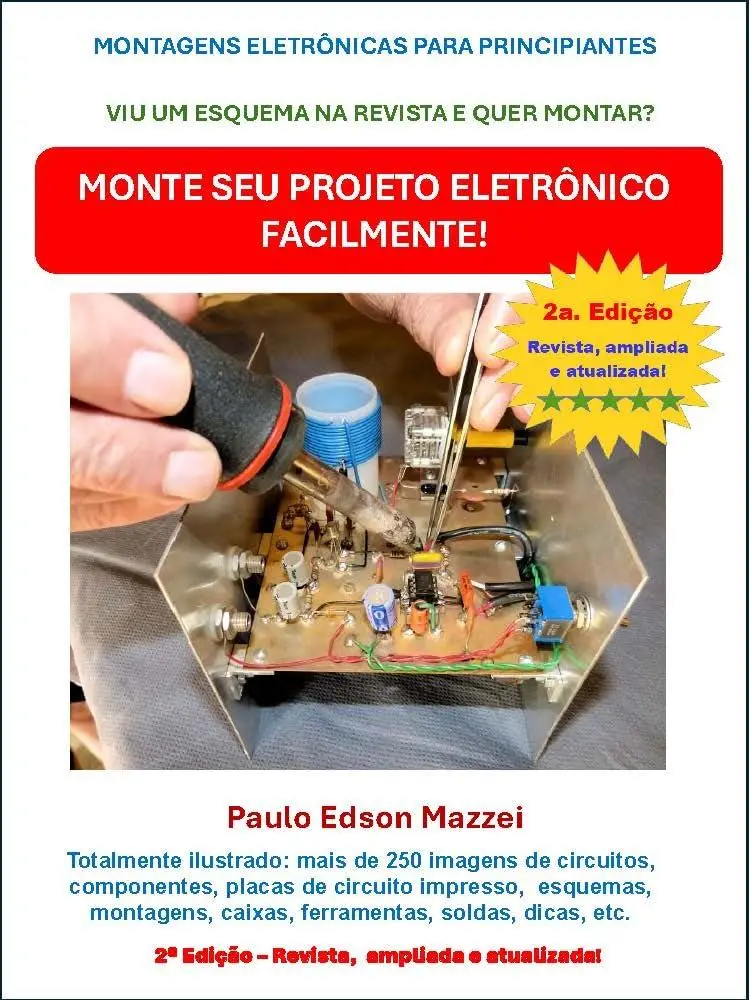Assemble your electronic project easily!: Electronic Assemblies for Beginners Translate: "Saw a schematic in the magazine and want to make it work? See how to do it step by step!!
by Paulo Edson Mazzei
English | March 10, 2024 | ASIN: B0CTHQLJ1S | 452 pages | PNG (.rar) | 127 Mb
by Paulo Edson Mazzei
English | March 10, 2024 | ASIN: B0CTHQLJ1S | 452 pages | PNG (.rar) | 127 Mb
What's New in the Second Edition, Revised and Expanded:
The second edition has been revised, but even so, you will undoubtedly find some grammatical, agreement, typing errors, etc. I believe you are more concerned with the technical aspects than the purity of the language!
In the expansion of this book, we improved:
a. More constructive information on PCBs – Printed Circuit Boards, which are the bottleneck in assemblies by amateurs.
b. More information on the use of VEROBOARD brand PCBs, excellent for beginners.
c. Inclusion of two entire chapters on testing active and passive electronic components!
d. Introduction of DC-DC converters, both step-up and step-down types.
e. Testing and development of projects with these DC-DC converters.
f. Real examples of constructing power supplies, etc., using DC-DC converters.
g. Example of building a radio receiver using the Manhattan method, illustrating perfectly how to go through the various steps.
I wrote this book to encourage you to venture into the assembly of small electronic devices, often featured in magazines, the internet, and technical books in the field. In many years of practice in the professional and teaching field of electronics, I have always encountered young and seasoned enthusiasts fascinated by electronics but lacking the courage to move forward and actually build something.
Technical electronics magazines, books in the field, and thousands of websites on the internet provide a vast amount of information on various areas of electronics, ranging from small power supplies to sophisticated homemade spectrum analyzers!
However, only a small part of this information reaches the beginner assembler in terms of what should really be done, starting with a brief description of the circuit and going into final details such as calibration and usage (sometimes). In the middle of this "Via Crucis," information is minimal but necessary for the beginner, such as drawing the layout of a printed circuit board, which is the difficulty in numerous assemblies. Other topics, such as reading schematic diagrams, layout, and designing boxes to house small projects, using test equipment, locating faults, almost never appear. The location (availability) and replacement of electronic components were not forgotten.
What I do in this book is provide tips on how to make an electronics assembly project "doable." I did not use any theory because to follow this eBook, you need to have basic knowledge of electronics. Hundreds of good books on the market and on the internet can help you delve deeper into the theoretical part of electronics.
If you don't know which one is suitable, and your budget is tight, I recommend checking out my series of eBooks published by Amazon, available at this link ELECTRONIC ASSEMBLIES FOR NON-TECHNICAL INDIVIDUALS.
The language used throughout the text aimed to be suitable for beginners, making you feel more comfortable taking on the assembly of an electronic device.
I also didn't have the budget to hire a proofreader for the text, but I believe readers are more interested in the technique than in the purity of the language. If this bothers you, send me an email with your suggestions.
However, enough of words, and let's get to work! Never let the soldering iron cool down…!!
Notes to Beginners:
Throughout this eBook, you will find references to older models of electronic components. No, the book is not outdated. The fact is that small circuit electronics assemblers are quite curious, and due to this, they may dismantle older electronic devices to retrieve parts and build other devices, as shown throughout this book! Dismantle older tube and transistor radios, TVs, etc., as they are a "gold mine" of components!!
Many new components are expensive and sometimes only found in specific places.



